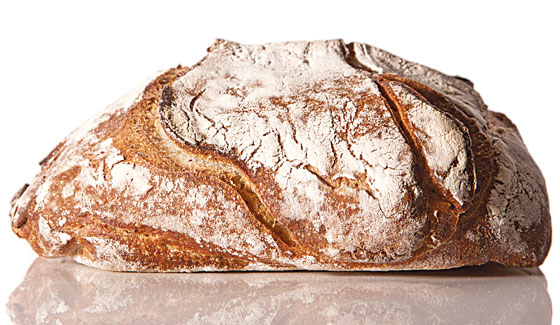
Over the millennia that bread has occupied a central role in mankind’s life and diet, it’s had some rough spots. One particular low point: the demonic rise of ultra-refined industrial bread in the middle of the last century, to be followed in quick, pitiless succession by the bread boycott sanctioned by Dr. Atkins and his low-carb comrades. (These events weren’t related, but they should have been.) Even while calorie counters were eschewing the staff of life in the eighties and nineties, real bread—in its naturally leavened, long-fermented, hearth-baked form—was enjoying a bit of a comeback hereabouts, thanks to pioneers like Bread Alone’s Dan Leader, Rock Hill Bakehouse’s Michael London, Tom Cat’s Noel Labat-Comess, and the indefatigable Eli Zabar, whose skinny sourdough ficelles flooded Manhattan gourmet stores and corner delis, reeducating the crust-deprived populace on how to chew.
Those bread avengers, and such like-minded successors as Amy’s Bread, Sullivan St Bakery, and Balthazar Bakery, looked to France and Italy. Now, a quarter-century later, a new wave of small-scale artisanal bakers are finding inspiration closer to home—specifically in upstate New York, where a nascent network of farmers and millers are reviving the region’s moribund wheat and flour industry, a development that’s manna for locavore chefs. You might trace this new bread movement back to the appearance of the Wild Hive Farm and Cayuga Pure Organics stands at Union Square Greenmarket, with their baker-bait arrays of flours and “ancient” grains, like emmer and spelt, that give multigrain (another current trend) new meaning. And then there’s the prevailing DIY spirit of a certain category of (primarily Brooklyn) establishment: Not only do they make the bread; they churn the butter, too.
On the following pages, you’ll find the definitive list (says us) of the city’s best new loaves and more on the state of baking in New York. We also check in with the godfather of today’s artisan bread, Jim Lahey, whose no-knead method revolutionized home baking, and who intends to do the same for the retail side of things at the new Chelsea outpost he plans to open next month. Like any perfectionist, Lahey casts a critical eye over the local breadscape. But after our thorough investigation of the subject, we have to say, the notion of living on bread alone? Not so terrible.
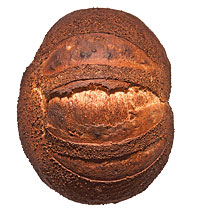
Baker’s Dozen
The city’s top-thirteen new-wave breads.
Roberta’s City White Loaf
Why would a nice young woman like Melissa Weller leave the cozy confines of the Per Se kitchen to toil practically outdoors like a longshoreman, baking bread in a converted shipping container in Roberta’s razor-wire backyard? Three words: Wood. Fired. Oven. That’s what’s inside the shipping container. And nothing, you see, can match the quality of bread baked in a domed-roof wood-fired brick oven. Weller’s City White is proof. Its crust is dark and crackling; its crumb pearlescent and moist as cake. “Rustic” doesn’t begin to describe this craggy loaf’s good looks: It’s like time-machine bread from some nineteenth-century communal oven outside of Rome or Paris.
261 Moore St., nr. Bogart St., Bushwick; 718-417-1118.
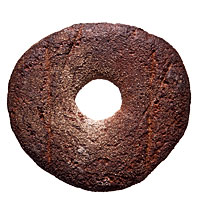
Nordic Breads’ Finnish Ruis
There’s more to rye bread than what you get at Carnegie Deli. Take, for instance, this Nordic newcomer. It’s a dark, dense, whole-grain triumph, flat as a Frisbee and with a distinctive tang that gains in complexity the more you chew. It is a bread of substance, of depth, and (as the packaging asserts) of such high fiber you can practically feel your constitution improve as you munch away. Concocted from organic New York State rye meal and a sourdough starter baker Simo Kuusisto smuggled in from Finland, the Ruis has expanded its retail presence from a New Amsterdam Market kiosk to Whole Foods shelves.
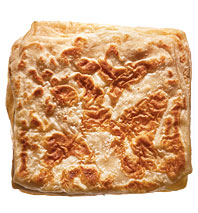
Hot Bread Kitchen’s M’smen
It’s a rare bakery whose repertoire ranges from freshly ground corn tortillas to Sephardic challah, but that multiethnicism embodies the mission of Hot Bread Kitchen: to train immigrant women to parlay their native expertise into management positions in the industry. Of all the breads produced at its East Harlem headquarters, the most exotic and delicious is the m’smen, a rough-textured, butter-and-oil-enriched North African flatbread that’s rolled, slicked, and folded into a delicious envelope of dough. Combining the rich flakiness of a croissant with the tender-crisp chew of paratha, the m’smen is griddled golden-brown and traditionally encountered at breakfast time in Marrakech. Here, find it tucked into the bread basket at Boulud Sud or stacked high at Hot Bread Kitchen’s Greenmarket stands.
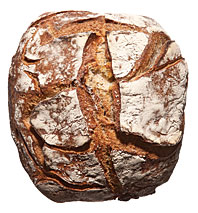
Runner and Stone’s Buckwheat and Pear
Technically precise, ingredient-restricted: That sums up Peter Endriss’s daily output as onetime head baker at Per Se and Bouchon Bakery, where the breads couldn’t contradict the food. So, for the most part, no nuts, no fruit, no cracked pepper, no onions, no experimental zaniness. Judging from his solo debut at New Amsterdam Market this fall, Endriss is compensating for years of flavor deprivation with assertive combinations like a Cheddar-and-hard-cider loaf, a sourdough whole-wheat walnut with dried sausage and red wine, and blockbuster pain au chocolat encasing port-infused figs. But his biggest evolution in style, which will be on full display at his forthcoming Brooklyn bakery, is a gravitation to local grains, natural leavening, and long fermentation. All three conspire to make his squarish buckwheat pear loaf a thing of crusty, nutty beauty, its speckled crumb a triple-grained canvas (there’s rye and spelt, too) for nuggets of sweet poached fruit.
Opening in 2012 at 285 Third Ave., nr. Carroll St., Gowanus; no phone yet.
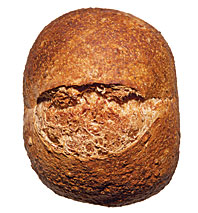
Roman’s Sprouted Spelt
No one does DIY like the Brooklyn restaurant group that includes Diner, Marlow & Sons, and Roman’s. As far as we know, there is no candlestick-maker on the payroll, but there is a butcher (several, in fact, at Marlow & Daughters butcher shop), and a baker, Austin Hall, who commandeers a corner of Roman’s kitchen after hours. That’s when he appropriates the wood-burning pizza oven, raked of its coals and swept of its embers, to bake breads for service and for retail sale on weekends. Chief among them: the naturally leavened sprouted spelt, a sturdy, burnt-umber sourdough loaf with a crackly, darkly caramelized crust and a crumb riddled with New York State spelt berries. It’s health bread for hedonists.
243 Dekalb Ave., nr. Vanderbilt Ave., Ft. Greene; 718-622-5300.
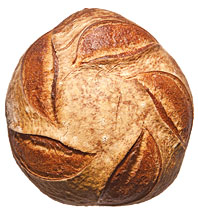
Bien Cuit’s Miche
This beautiful loaf of bread is called a miche, the style most closely associated with the late, great Parisian baker Lionel Poilâne. It’s made from a wild yeast starter and a blend of five rye and wheat flours. The dough is gently folded, lovingly shaped, and generally babied at regular intervals throughout the morning. Then it ferments for up to 68 hours, a.k.a. 2.8 days. In short, you don’t so much as make this bread as give birth to it. Fresh from the oven, it weighs five pounds, thirteen ounces. It’s dense and chewy and full of complex flavors that unfold in steady waves that linger on your palate. The proud papa is Zach Golper, who ran the bread ovens at Philadelphia’s Le Bec-Fin before he and his wife opened their lovely Boerum Hill bakery, whose name means “well-done” en français.
120 Smith St., nr. Dean St., Boerum Hill; 718-852-0200.
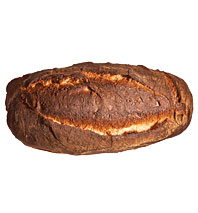
Sullivan St Bakery’s Truccione Saré
What’s it take to master the art of bread-making? Well, let’s put it this way: Jim Lahey’s been at it for over twenty years, and when you tell him that his latest pet project, his Truccione Saré loaf (natural fermentation, some upstate wheat, minimal kneading), is one of the best breads you’ve ever had, what’s his response? “It’s only 60 percent there.” Did we mention he’s been tinkering with this loaf for a year and a half? The name, incidentally, like many names in Laheyland, is pure fiction, 100 percent made up. One bite, though, and you know this bread is real. The crust is the deep black-brown of a well-roasted chestnut. The crumb: springy, creamy, exquisitely moist. When you tear into this thing, it crackles like a croissant. You could go ahead and slap some butter on it, but why mess with 60 percent perfection?
533 W. 47th St., nr. Eleventh Ave.; 212-265-5580.

Épicerie Boulud’s Pain Levain
If you’ve broken bread at any of Daniel Boulud’s restaurants, you know Mark Fiorentino’s work. For twelve years, he’s been M. Boulud’s secret weapon, kneading away in the tiny basement bakery kitchen of the 65th Street mother ship, filling bread baskets scattered across the D.B. universe. Those superb little olive-rosemary rolls at Daniel proper? A Fiorentino signature. DBGB’s burger buns? His. The pretzel rolls at DB Bistro Moderne? Yep, Fiorentino. With the opening last spring of his takeout café Épicerie Boulud, and the decision to bestow Fiorentino’s bread upon the retail masses, Boulud finally gave his bread man a spacious downtown commissary to call his own. Everything he bakes there for Épicerie Boulud, from baguettes to focaccia, is top-notch, but this junior-football-size whole-grain pain au levain is his (and our) personal favorite. It’s an earthy-flavored, mildly acidic, wonderfully chewy little country loaf made in the fashion of the day from a multitude of flours, a smattering of bran, germ, and whole oats, and decades of classic technique.
1900 Broadway, at 64th St.; 212-595-9606.
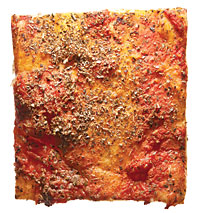
Eataly’s Focaccia
Of all the breads churned out of the wood-burning oven at Batali & Bastianich’s Italo-gastro-theme-park, it’s the focaccia, baked from a blend of organic stone-ground New York State flours, we can’t resist: soft and open-crumbed, with a sumptuous mouthfeel and a flavor suffused with salt and olive oil. The surface is smooth and golden, the edges faintly crisp, and the first-rate toppings applied sparingly so as not to detract from the dough’s yielding quality. (“The crumb should melt before it hits the back of your throat,” says baker Paul Mack.) The version painted with bright crushed tomatoes (Mutti, Eataly’s house brand) is savory, satisfying proof that the simplest things are often the best.
200 Fifth Ave., at 23rd St.; 212-229-2560.
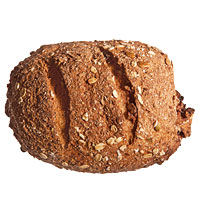
Scratchbread’s Bourbon Wheat
How do you know when you’re eating one of Matthew J. Tilden’s loaves? When you bite it, it bites back. “I use probably triple the amount of seasoning as anyone else,” says Tilden, who considers most breads “bland.” This is not an issue with his extra-crusty, pretzel-salty “aged” sourdoughs, the alterna-rye he calls the “Mutt,” with its hidden caches of burnt caraway seeds and black peppercorns, or his Parmesan-crusted, fennel-seed-striped Parma Loaf. The dense, nourishing Bourbon Wheat is a crunchy powerhouse of whole grains, from Cayuga Pure Organics whole wheat to spelt berries. Pumpkin seeds, pecans, and bourbon-soaked currants and raisins add to the textural complexity. Pair it with cheese and you’ve practically covered all the major food groups.
1069 Bedford Ave., at Lexington Ave., Bedford-Stuyvesant; 917-868-6723.
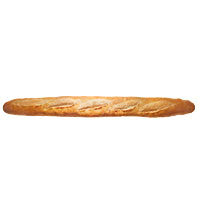
La Boulangerie’s Baguette
The French love their bakers. Next to firemen, bakers get the most votes in French public-opinion polls asking people about those they esteem most. Maybe that’s why Brittany-born François Danielo left his career as a mechanical engineer to open a boulangerie in bread-starved Forest Hills. (Mechanical engineers do not rank high in public-opinion polls.) He made the right choice. Since its July opening, his modest shop has been like Macy’s on Black Friday. What’s all the fuss about? Croissants, pains au chocolat, naturally leavened boules, but most of all Danielo’s classic baguettes. These sticks are light, airy, fragrant, toasty, creamy, crackly—in short, everything a baguette should be. Now Danielo is a local hero, and Forest Hills firemen are all atwitter.
109-01 72nd Rd., Forest Hills; 347-644-5606.

Vandaag’s Red Ale Pumpernickel
They don’t play it up; in fact, you practically have to interrogate the staff before someone will admit it, but this East Village restaurant sells delicious, trippy, vaguely Scandinavian breads to the persistent retail customer. The in-house baker Nathan Berg is a second-generation bread man (his father, Norman, recently co-authored the terrific Inside the Jewish Bakery), and everything he puts in his bread basket can be purchased by the loaf. There’s hay-smoked country white, seaweed focaccia, and a nice honey-wheat. Our favorite, though, is the red-ale pumpernickel made from a mix of upstate flours. It’s a crisp-crusted, chestnut-hued loaf with a pleasantly boozy, mushroomy aroma. They say that beer is liquid bread; this is edible ale.
103 Second Ave., at 6th St.; 212-253-0470.
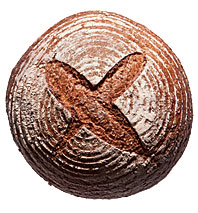
Orwasher’s Ultimate Whole Wheat
If you associate multigrain with the words leaden, bricklike, and hardtack, this seed-studded boule will prove you wrong. It’s a newish addition to the pumpernickely old-world repertoire at Orwasher’s, the Yorkville institution bought four years ago by Keith Cohen, a baker who’s been known to capture wild yeasts from South Fork wine grapes, among other locally inspired larks. The Ultimate is Cohen’s airy, springy showcase for organic whole-wheat flour milled from hard red winter wheat by the Finger Lakes collective Farmer Ground Flour, which counts Cayuga Pure Organics as a partner. That’s why you’ll also find the bread, a bulk-aisle cornucopia of rye, millet, flax seeds, oats, sunflower seeds, and sesame seeds, at Cayuga’s Greenmarket stand, and why the Ultimate just might be the edible symbol of New York’s locally grown-and-milled-flour movement.
308 E. 78th St., nr. Second Ave.; 212-288-6569.